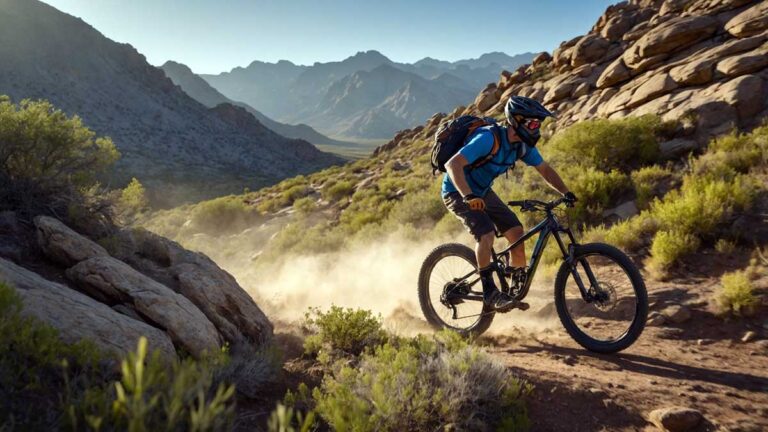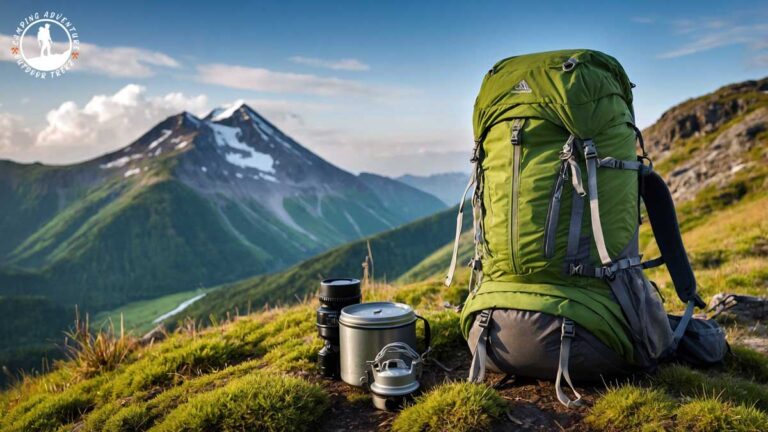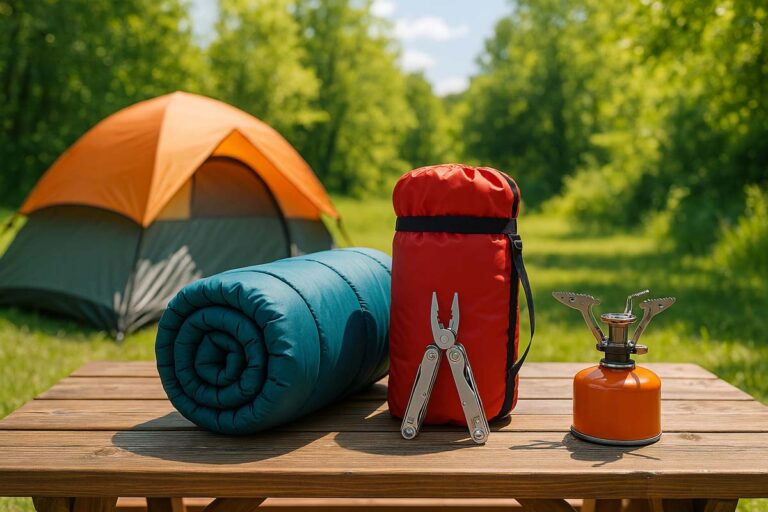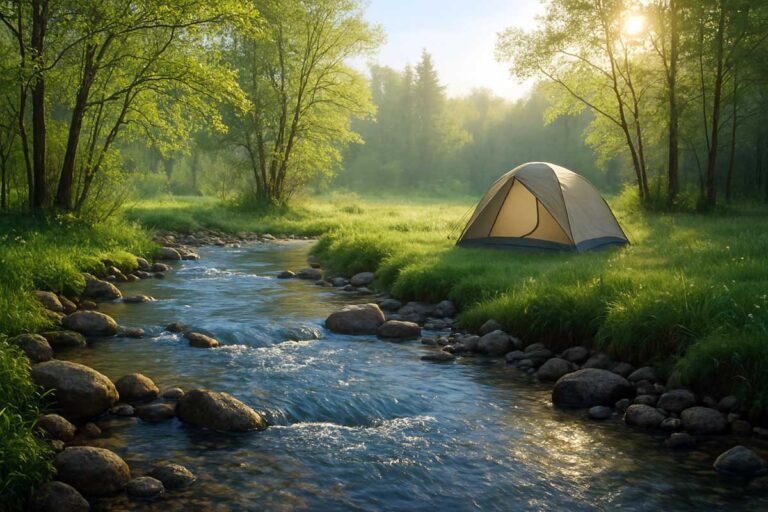How Much Water to Bring When Camping: 7 Essential Tips for Your Next Trip
How much water to bring when camping? Grab clear, actionable advice for a worry-free trip. Plan smart and stay well-hydrated on your outdoor journey
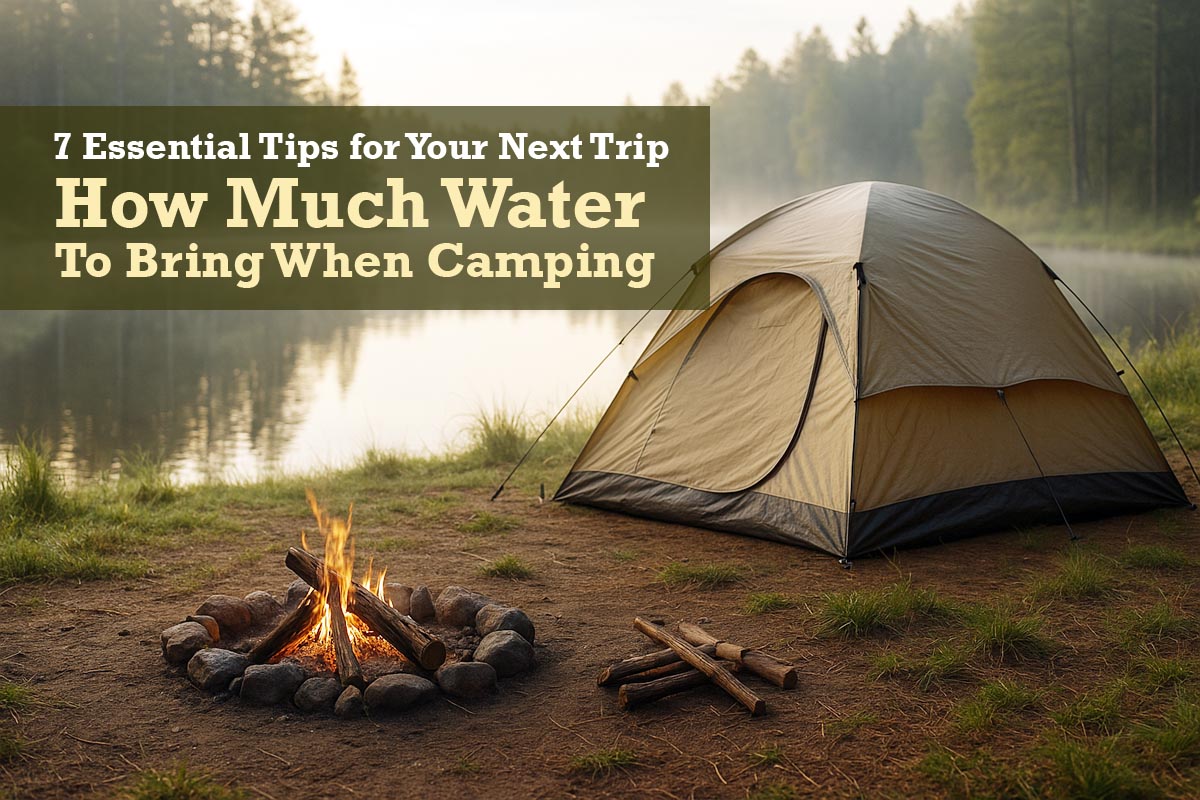
How much water to bring when camping is a question that often comes up among campers. As a camper, I have learned from years of camping trips across various terrains that proper water planning is essential for a safe and enjoyable outdoor experience. In this article, I will offer clear guidance on how to determine the right amount of water to bring on your camping trip. The tips shared here are based on real-life experience and careful planning. They will help ensure that you have enough water for drinking, cooking, cleaning, and other uses while on the trail.

Contents Include
- 1 Understanding the Importance of Water on a Camping Trip
- 2 Factors That Influence Water Consumption
- 3 Estimating Your Water Requirements
- 4 How much water per person per day camping?
- 5 Best Practices for Water Storage and Transportation
- 6 Additional Tips for Efficient Water Use
- 7 Planning for Emergencies and Water Shortage Scenarios
- 8 Real-life Examples and Tips from My Experience
- 9 Practical Checklist for Water Planning
- 10 Final Thoughts
Understanding the Importance of Water on a Camping Trip
Water is a basic need in any outdoor setting. It is critical not only for hydration but also for safe food preparation, proper cleaning, and maintaining personal hygiene. Before diving into specifics, it’s important to appreciate why water is such a critical element on any camping trip. Water is essential for:
- Hydration: Our bodies need a steady supply of water to function properly, particularly when you’re physically active outdoors.
- Cooking and Cleaning: Water is required for food preparation, washing utensils, and general cleanup.
- Hygiene: Maintaining personal hygiene is especially important on multi-day trips to prevent discomfort and illness.
- Emergency Use: In unexpected situations, additional water may be needed for medical or safety reasons.
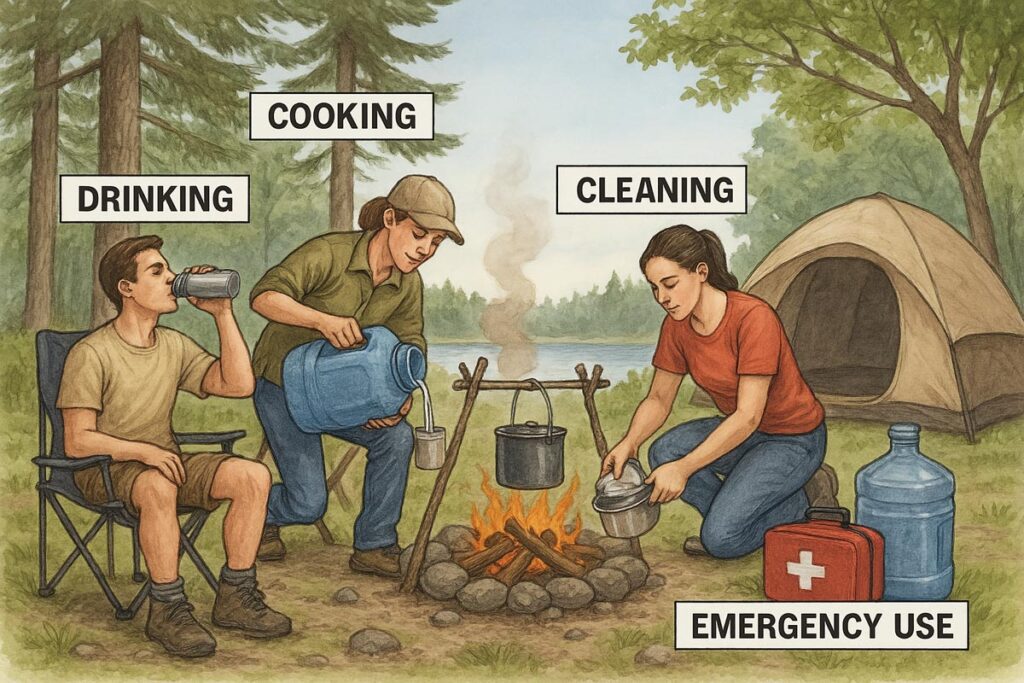
Knowing what water is needed for helps set the stage to determine exactly how much water to bring when camping. Each trip will have its own set of requirements and constraints, which we’ll cover in detail in the following sections.
Factors That Influence Water Consumption
The volume of water you need while camping depends on several factors. It’s not a one-size-fits-all answer. The key influences include:
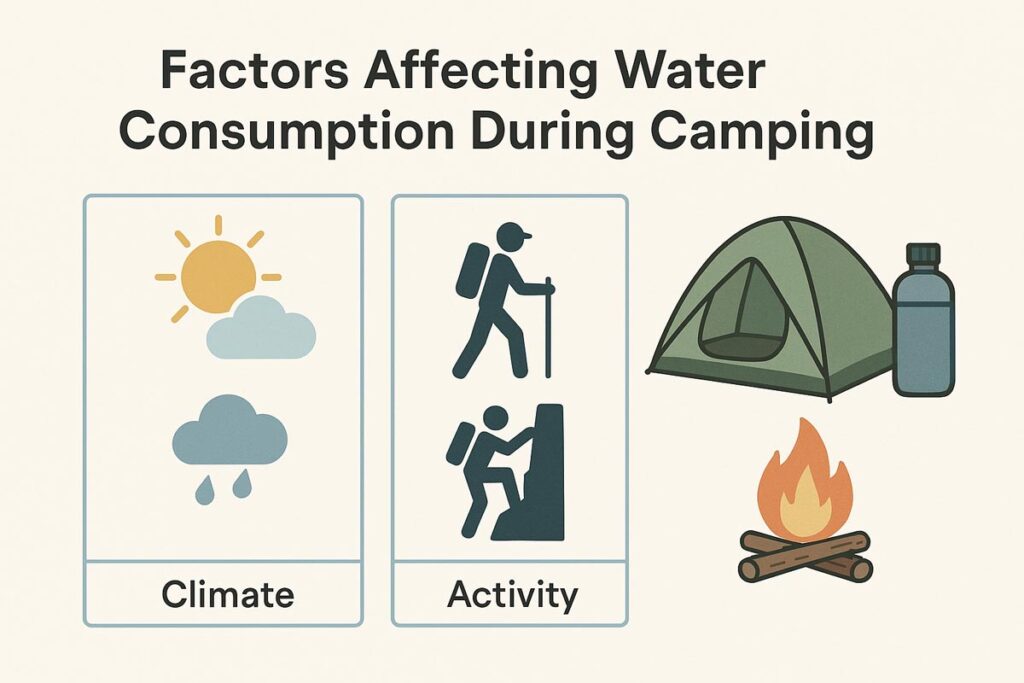
Climate and Environment
- Temperature and Humidity: In hot and dry environments, your body loses water faster through sweat. In humid conditions, you may not feel as thirsty, but hydration is still important.
- Altitude: At higher altitudes, water loss increases due to drier air and increased respiratory demands.
- Season: Summer trips usually require more water compared to cooler seasons.
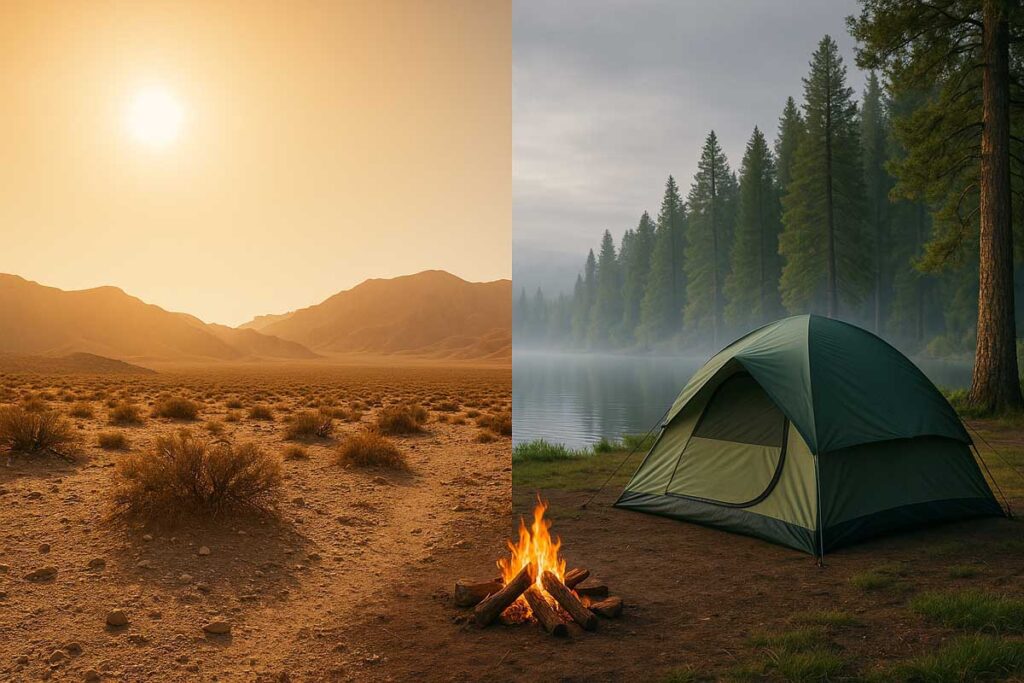
Activity Level and Duration
- Intensity of Activity: Activities like hiking steep trails, rock climbing, or intense physical labor demand more hydration compared to relaxed activities around the campsite.
- Trip Length: Longer trips naturally require a greater amount of water both for hydration and for other uses like cooking and cleaning.
- Personal Physiology: Each person’s hydration needs can vary based on body size, metabolism, and overall health.
Type of Camping
- Backpacking vs. Car Camping: When backpacking, you must balance weight and volume. In contrast, car camping allows you to bring extra supplies without worrying about carrying every item.
- Group Size and Demographics: More people or a mix of different ages (e.g., children, elderly) can lead to varied water consumption requirements.
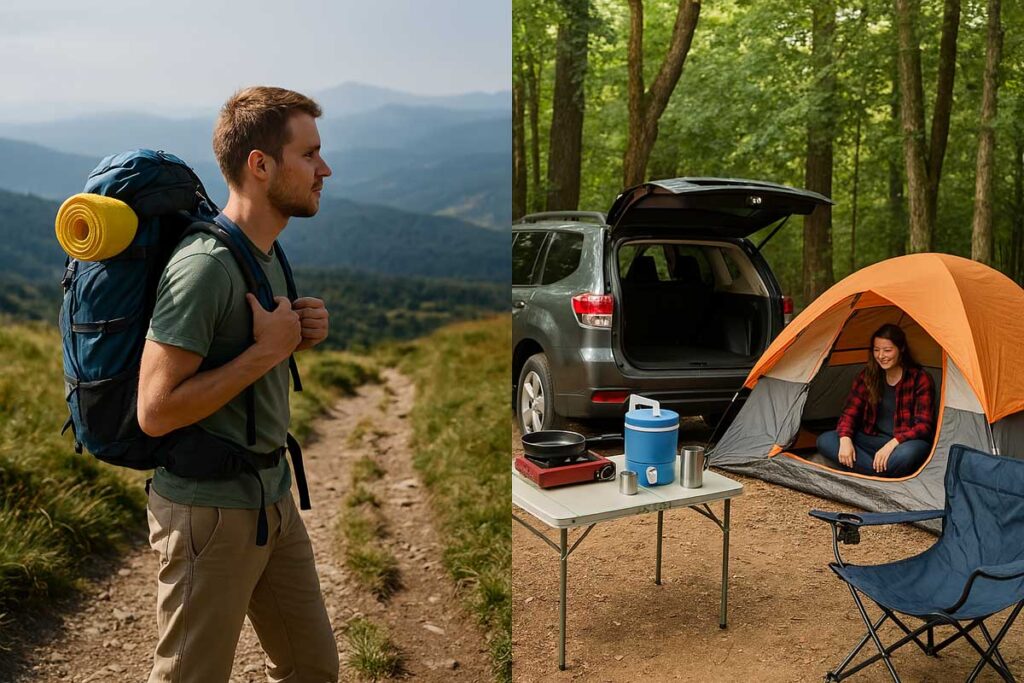
Understanding these factors is crucial in planning your water needs effectively. This section sets the foundation for estimating water requirements, which we’ll address next.
Estimating Your Water Requirements
Estimating the amount of water you need begins with understanding a few basic guidelines and then adjusting based on your specific circumstances. Here’s a step-by-step approach:
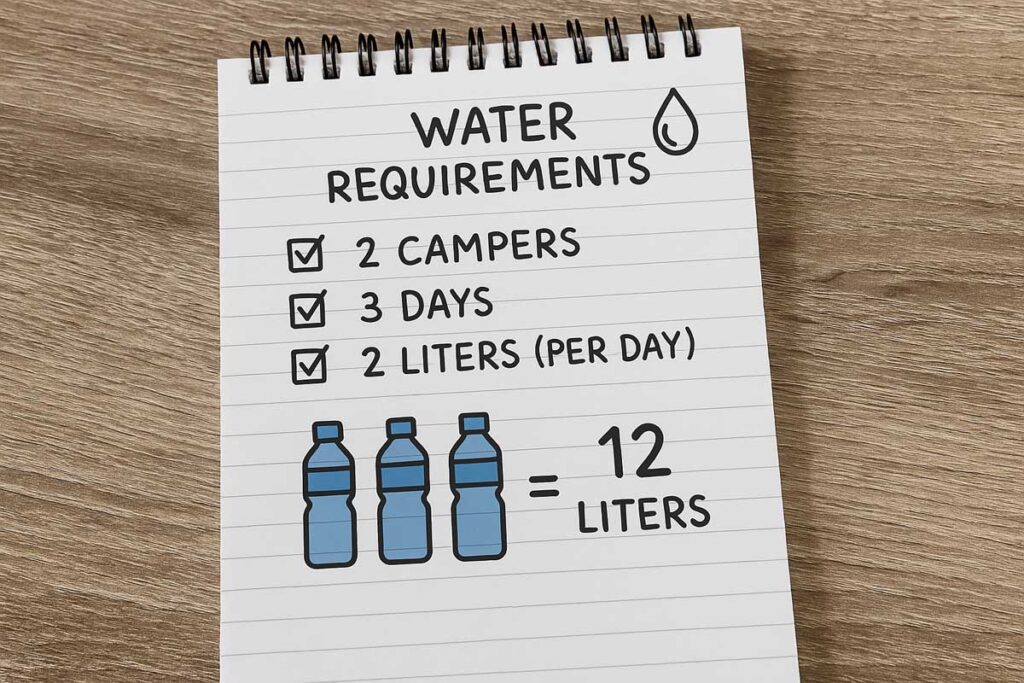
Step 1: Calculate Basic Daily Needs
For hydration:
- The general recommendation for water intake is about 2 to 3 liters per person per day under normal conditions.
- On physically demanding trips or in hot weather, it’s wise to aim closer to 3 to 4 liters per person per day.
For non-drinking uses:
- Consider extra water for cooking (roughly 1 to 2 liters per person per day) and for cleaning or minor hygiene tasks.
Step 2: Adjust for Activity and Environment
- High-intensity activities or extreme temperatures: Increase the water estimate by an additional liter per person.
- Group considerations: Multiply the per-person water requirement by the number of people in your party. For example, a group of four on a strenuous two-day hike might need 16 to 20 liters of water (4 liters per person per day).
Step 3: Plan for Contingencies
- Emergency Buffer: Always add an extra day’s supply per person as a safety net, particularly if you’re in a remote area where water sources are scarce or unreliable.
- Additional Uses: If your trip involves camping in areas without established water sources, or if you plan on cooking meals that require substantial water, factor these into your calculations.
Step 4: Document Your Estimate
Write down your water plan before your trip. This checklist should include:
- Daily drinking water needs
- Water for cooking and cleaning
- An emergency reserve
For example, for a three-day trip in hot weather with moderate activities, if you estimate:
- 3 liters per day for hydration,
- 1 liter per day for cooking and cleaning,
- An extra 3 liters for emergencies,
your total would be: (3 + 1) liters × 3 days = 12 liters, plus 3 liters for emergencies, coming to 15 liters per person.

This systematic approach can help ensure that you always have enough water on hand and adapt easily to the specifics of your trip.
Also see: How Long Should 230gals of Water Last Camping
How much water per person per day camping?
The recommended amount of water per person per day when camping is 3 to 4 liters. This includes about 2 to 3 liters for drinking and 1 liter for cooking, cleaning, and hygiene.
If you’re camping in hot weather, at high altitudes, or doing strenuous activities, you should increase that to 4 to 5 liters per person per day. Always carry a little extra in case of unexpected situations or delays. Proper planning helps you stay hydrated and safe throughout your trip.
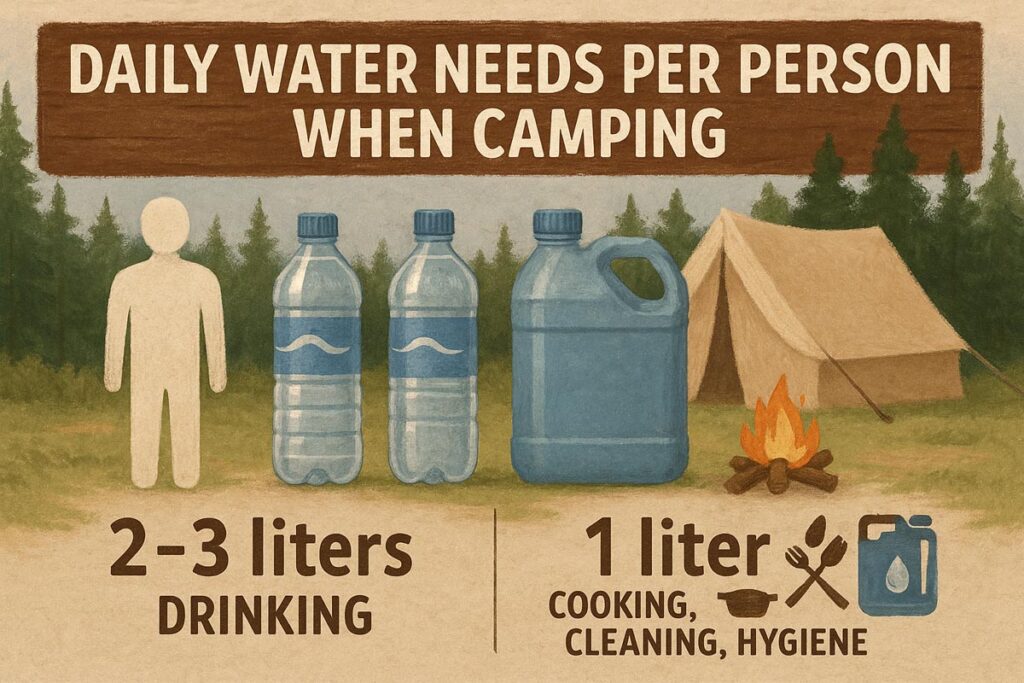
Best Practices for Water Storage and Transportation
Carrying water while camping can be challenging, especially when weight and space are limited. However, the strategies below can help manage and optimize your water supply:
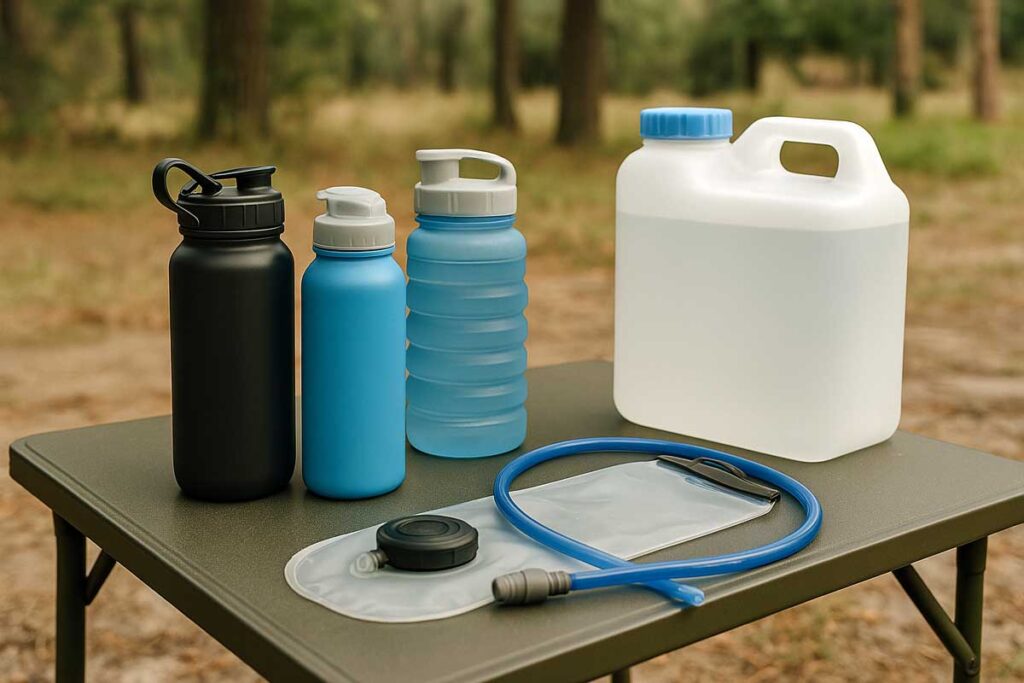
Choose the Right Containers
- Durable Water Bottles: Opt for sturdy, leak-proof bottles made for outdoor use. Collapsible water bottles or hydration bladders are excellent for backpacking because of their minimal weight and space requirements.
- Multi-use Containers: Use containers that can serve both as drinking vessels and for cooking purposes. This helps reduce the number of items you need to carry.
Pack Efficiently
- Organization: Use a method that keeps your water containers secure in your backpack. Water weight is significant, so distribute the load evenly.
- Access: Ensure your water is easily accessible during activities. Hydration bladders, for example, allow you to drink without having to stop and unpack a bottle.
- Extra Considerations: In scenarios where water weight might be an issue, plan for water stops along your route. In many areas, natural water sources can be treated and used to supplement your supply.
Use Technology for Added Security
- Water Filters and Purifiers: Carry a reliable water filter or purification tablets. This technology allows you to use natural water sources, reducing the amount you need to carry from the start.
- Insulation: In cold weather, insulating your water containers can prevent freezing, ensuring that you have a usable supply throughout the day.
Adopting these strategies not only minimizes the burden of carrying water but also ensures that your supply is manageable and safe to use during your adventure.
Read more: How to Find and Purify Water in the Wild
Additional Tips for Efficient Water Use
Efficiency is crucial when planning your water supply. Here are some additional tips to help you optimize your water usage while camping:
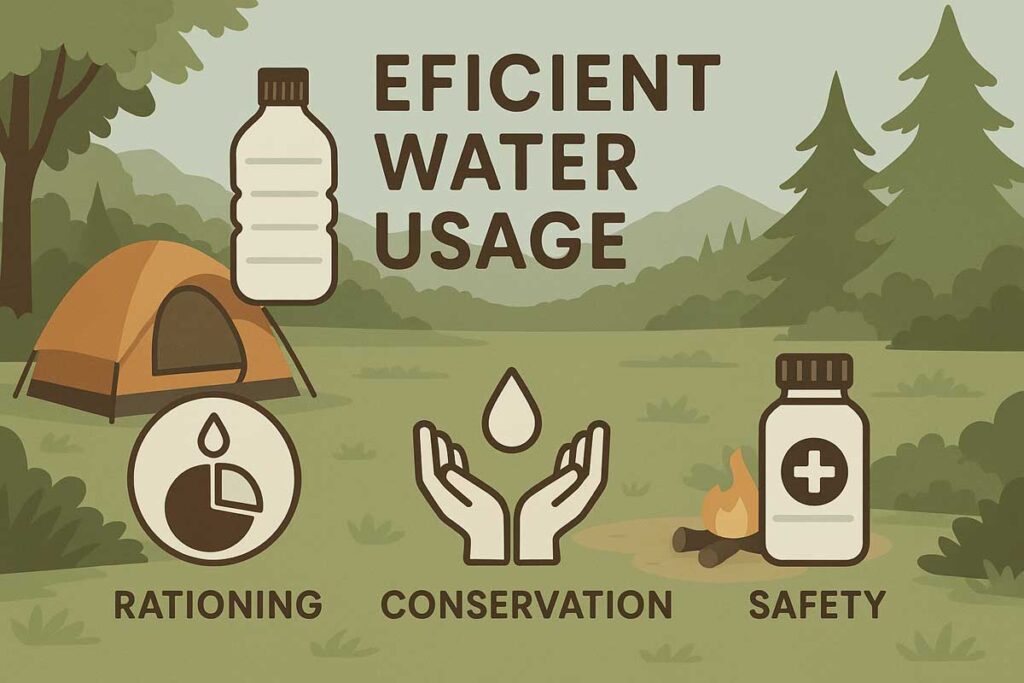
Water Rationing Techniques
- Scheduled Sips: Rather than waiting until you feel parched, try to drink small amounts of water throughout the day. This approach helps maintain hydration and prevent over-exertion.
- Meal Planning: Prepare meals that require minimal water for cooking. Pre-cooked or dehydrated meals can reduce the water needed for rehydration and cooking.
- Reuse Water Safely: When possible, reuse water from cooking for washing utensils or even pre-rinsing dishes. Ensure the water is not contaminated if you plan to reuse it for drinking purposes.
Conservation Strategies
- Mindful Consumption: Track your water usage so you’re aware if you’re using more than anticipated. Having a daily log can provide insights into how to better manage your supply on future trips.
- Minimize Waste: Use water sparingly for tasks like cleaning. Carry biodegradable soaps that work well in small quantities and wash dishes carefully to make the most of every drop.
- Plan for Multi-Use: Where safe, use the same water for different purposes. For instance, water used for washing vegetables can sometimes be repurposed for non-consumptive cleaning.
Health and Safety Measures
- Regular Breaks: Make hydration part of your routine. Schedule regular breaks to drink water, especially when engaging in strenuous activities.
- Monitor for Dehydration: Learn the signs of dehydration—such as dark urine, headache, and fatigue—and act immediately if you or someone in your group exhibits them.
- Quality Assurance: Always treat water from natural sources. Even if it looks clean, natural water may contain contaminants that can lead to illness.
These measures will help ensure that your water is used wisely and that you maintain optimal hydration throughout your camping experience.
Planning for Emergencies and Water Shortage Scenarios
Despite the best planning, there may be times when unforeseen circumstances disrupt your water supply. Here’s how to prepare:
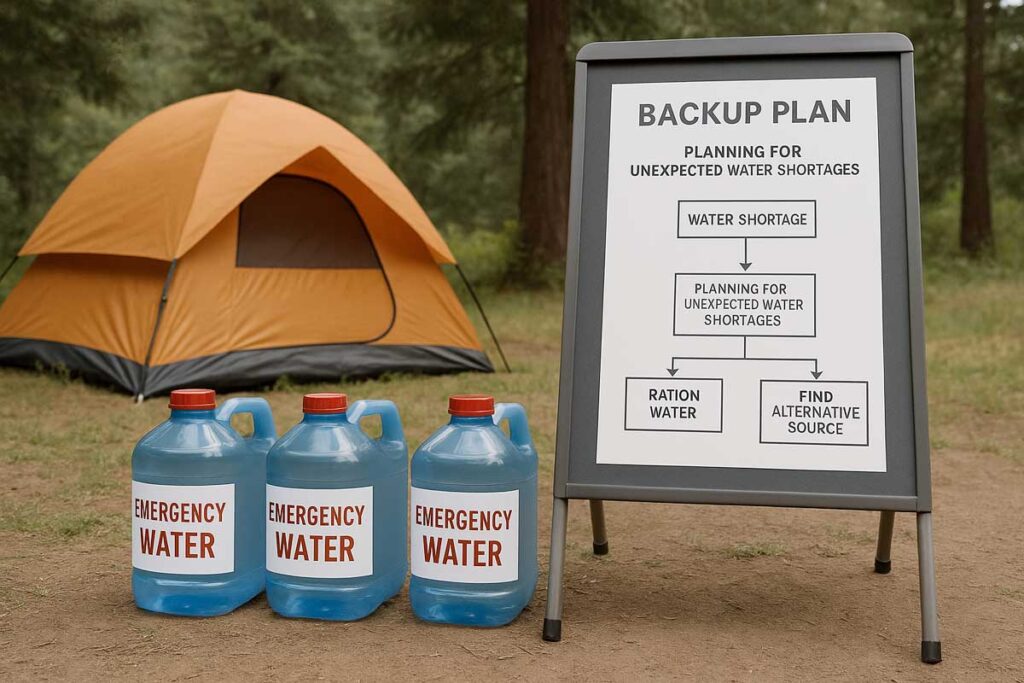
Stock an Extra Supply
- Emergency Reserve: As a rule of thumb, pack an extra day’s worth of water for each person. This buffer can be a lifesaver if you face unexpected delays or need extra hydration.
- Easy Access Storage: Place your emergency reserve in an easily accessible part of your pack. This ensures that you can quickly reach it if needed without disturbing your other supplies.
Identify Alternative Water Sources
- Natural Sources: Research your route in advance to identify streams, lakes, or springs where water is available. Make a note of these on your map.
- Water Quality Testing: Equip yourself with a portable water testing kit if you’ll be relying on natural sources. This can help determine whether you need additional purification methods.
Incorporate Water Purification Methods
- Filtration Systems: Invest in a reliable water filtration system. Filters that remove bacteria, protozoa, and even viruses are invaluable.
- Purification Tablets: Keep a small supply of water purification tablets as a backup method. They are lightweight and easy to carry, making them ideal for emergency situations.
Develop an Emergency Plan
- Group Communication: Ensure all group members know the water plan and the locations of emergency reserves.
- Regular Check-ins: If camping in remote areas, check in with someone outside your group at regular intervals. This precaution helps in case someone falls ill due to dehydration or if a water source becomes unavailable unexpectedly.
By planning for emergencies, you can manage water shortages with confidence, ensuring that your trip remains enjoyable regardless of potential setbacks.
Real-life Examples and Tips from My Experience
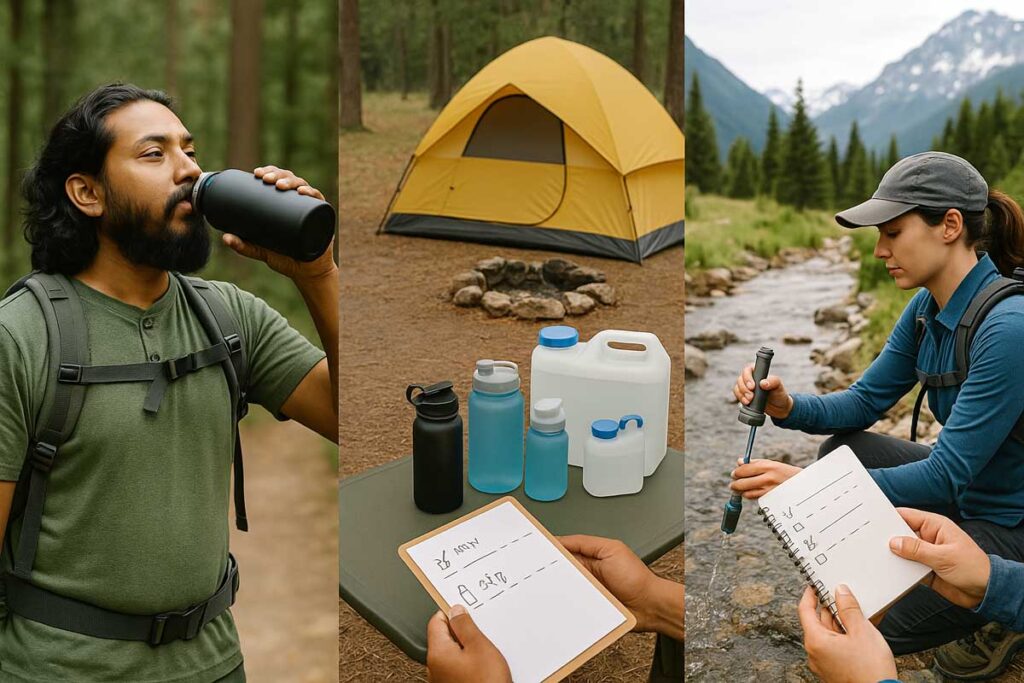
I have been on many camping trips over the years, and a few examples can help illustrate why accurate water planning is important:
- Short Day Hikes: For a day hike in a shaded forest, carrying enough water for one to one and a half times your expected consumption has proven sufficient. However, I always bring extra water in case of a longer-than-planned break or a change in weather.
- Weekend Camping Trips: When planning a two or three-day trip, I calculate the water needs by adding extra for cooking and cleaning. I recall one weekend when the weather turned unexpectedly warm; having an additional reserve prevented dehydration and the need to alter our planned itinerary.
- Extended Backpacking: On longer trips where carrying a large volume of water is not feasible from the start, I rely on known water sources along the route. In these cases, water purification equipment and pre-validated water sources become critical parts of my planning.
In each scenario, it is the careful assessment of potential risks, the flexibility in planning for various conditions, and the mindful use of water that leads to a successful trip.
Practical Checklist for Water Planning

Before setting out, ensure you have covered these key points:
- Write down the total number of days and the group size.
- Divide water needs into drinking, cooking, and cleaning requirements.
- Adjust the standard one gallon per person per day guideline to account for physical effort, climate conditions, and extra needs.
- Plan for additional water based on group meals and potential emergencies.
- Choose suitable water storage containers that are durable, lightweight, and leak-proof.
- Prepare water purification equipment if you plan on obtaining water from natural sources.
- Keep a record of water consumption during the trip to help with planning future trips.
Using this checklist can help you stay organized and reduce the risk of running out of water.
Final Thoughts
Planning how much water to bring camping is a critical part of preparing for any outdoor trip. From understanding personal water needs and assessing the impact of weather and physical activity, to choosing the right storage options and making decisions about purification methods, every detail plays a role in ensuring your safety and comfort. Remember, the key points to consider include:
- Daily Consumption: Estimate approximately 2–4 liters per person per day depending on the intensity of your activities.
- Multipurpose Use: Account for water needs beyond just drinking—include cooking, cleaning, and hygiene.
- Safety Preparations: Prepare for emergencies by carrying an extra day’s reserve and using reliable water purification methods.
- Efficient Packing: Choose the best containers and make sure your water is accessible and safely stored.
- Responsible Use: Follow conservation practices to keep our camping areas pristine and environmentally friendly.
I hope this comprehensive guide helps you plan your next camping trip with confidence. Having the right amount of water is not only about staying hydrated but also about ensuring that every aspect of your trip—from cooking to cleaning—is taken care of.
Enjoy your camping experience, and may your adventures be safe and well-hydrated. For more insights and tips on outdoor planning, feel free to explore more articles on OutdoorTrekz.com. Stay safe, stay hydrated, and happy camping!


